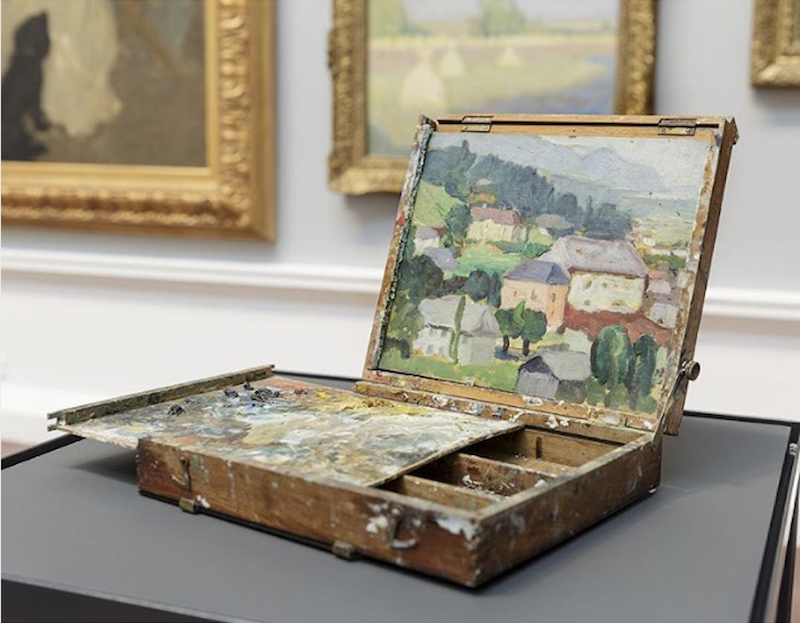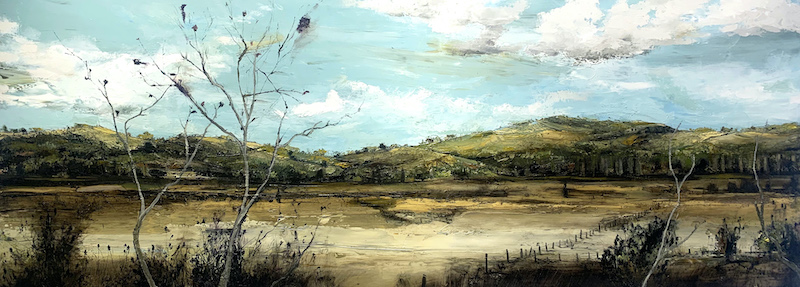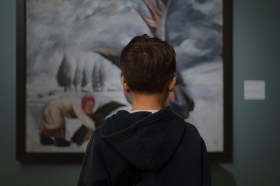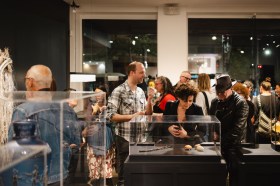Amanda Penrose Hart started painting outdoors when she could no longer afford to keep her Sydney studio.
‘It was OMG this studio has to go! And it was like having my hand cut off. But then I started painting in my car. I would drive somewhere, and put my bum down somewhere in the shade and just look. Slowly it took over.’
‘Now I can just pick up my kit and go anywhere – to France or out bush. It is super portable and I have learnt how to find shade … and bad food,’ said Penrose Hart.
She has a system of travelling now with a big suitcase on wheels filled with art materials and a small bag of clothes, adding that the switch in priorities has been liberating.
It was a similar experience for New Zealand-born Sydney painter Euan Macleod, who said: ‘I just love it that you go out and look, and you are looking at things. rather than making things up.’
You see things you would never normally see, and it is a huge shift from painting stuff just out of head.
Amanda Penrose Hart.
‘I did it secretly for a long time,’ he continued. ‘When it was so uncool for so long.’
‘It is funny the shame you used to feel doing them. Me, John Walker and Julie Harris used it to when never show them. I know Rick Amor was the same; he was doing a lot. But now it seems to be Ok. I hear Peter Sharp has got a show of them coming up.’
‘I think it has been coming back for a long time, but people [still] don’t know what to make of it – is it cool or uncool now?’ said Macleod.

Bessie Davidson, Artist paintbox with French coastal landscape, c 1930. Collection of Art Gallery of South Australia. Image courtesy AGSA.
WHAT’S THE APPEAL?
Artist Sally Stokes told ArtsHub the appeal was about connecting and focussing.
‘It’s my way of connecting to the landscape, to see its diversity, to see new patterns, new orders and amongst the concentration new insights may emerge … As I sit and draw life seems to happen, changing light, different colours move back and forth, sounds change, leaves talk. All changes. All continues,’ Stokes said.
Macleod says he still goes out drawing at least once a week. ‘Generally on the weekend I do a bit of sketching somewhere.’
‘Sometimes it’s important to go back to the source,’ he said. ‘En plein air is just a practice, like life drawing.’
‘When I was at art school you didn’t exhibit them – it was just a means to an end,’ he added that his teacher at art school called them ‘holidays – to not think too much the thing in front of you. If you try to think too hard, and reinvest Western painting traditions in the moment, it all falls out the door.’
He added with a laugh, ‘but you also don’t want to be too slavish to what’s in front of you.’
Macleod made the point that while painting in the landscape can be a solitary exercise, it can also be thing you can do with other people. ‘The social aspect is lovely,’ he said.
Similarly, Stokes has been part of a group that has met weekly for the past forty years, to paint and draw in the landscape.
‘Gathering visual ideas and chatting over a thermos coffee after we meet up, to discuss all things of the world, but particularly exhibitions, films, literature and life,’ she explained is all part of the joy.

Euan Macleod says just burn it, if it doesn’t work. Photo Andrew Merry.
FINDING HUMANITY IN THE OBSCURE EN PLAIN AIR EXPERIENCE
All three artists said that people who encounter them, most commonly say: ‘OMG do you actually sell those!’, adding that you can hear in their voice they clearly think its crap.
But some people are lovely too, said Macleod. ‘I had a couple in New Zealand watch me painting and then went and bought it. And then others have said, ‘Hey if you’re gonna throw it away, I’ll give you ten bucks for it.’
He added he has had lot of experiences with police. ‘When you are looking for places to paint it sometimes looks like casing out a place – that you are up to no good – and the police turn up all Starsky and Hutch [1970s TV series].’
Macleod says he has tried to be a bit more open to people lately. ‘It’s not easy to talk and paint, and people don’t realise that … And they love to stand in front of you, right where you are trying to paint.’
While Stokes says she has had her share of encounters with snakes, most memorable was, ‘canoeing in the high tide to the mangroves (canoeing there is like entering a cathedral – the light and silence is another world,) Fellow artist Viola Dominello in the front of the canoe was collecting the scum for the tide onto her water colour paper. What an artwork the randomness became with her efforts!’
Recently Stokes has been drawing to the Hawkesbury River. ‘I’ve worked out ways to draw from the canoe. All give different perspectives about how we can live on this endangered planet.’
The message seems to be go with the flow, and don’t be afraid to try something different.
‘All my work begins with drawing en plain air,’ says Stokes. ‘My en plein air work is about ideas that may lead to an artwork. They are rarely an artwork in themselves.’
‘It’s my way of getting ideas to paint from, and to sit silently amongst the bush or river or mountains or desert, connecting me to the mysteries of being a human on this planet.’

Amanda Penrose Hart, Lake George 2020. Image courtesy the artist.
TIPS ON PAINTING OUTDOORS
Penrose Hart says when she is out painting outside, she will leave her paintings to dry in the car – along the back seat, parcel shelf and boot.
She continued: ‘I had to reduce the size I worked … and oil paints are great because they are firm – stable – and won’t drip anywhere; plus the fresh air means no fumes.’
Top of everyone’s list of tips was to find a comfortable place to work.
Penrose Hart said her quick tip for getting started is to use your rear vision mirror in the car. ‘I often paint in my ute. Use the mirror to look at what is behind you. It is an automatic view-finder. Sometimes when you are faced with a 180 degree view it’s overwhelming. It is about controlling how you see.’
Stokes offered the tip to ‘go back to the same place often so that your drawing insights get deeper, so you are not just relying on the newness for results.’
She added that she starts out drawing with a graphite pencils, then moves to compressed charcoal, maybe some ink ones and then a series of gouaches. Unlike Penrose Hart who likes to dive in with oils on the road, Stokes waits until she returns to the studio, using her sketches in a foundational way.
Macleod said: ‘Don’t worry so much about finding a fab subject – anything can be a subject – you can make a drawing of anything.’
He concluded simply, ‘Try and enjoy it!’
Both Macleod and Penrose Hart are represented by King Street on William Gallery in Sydney. You can see Sally Stokes’ work on her website





